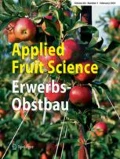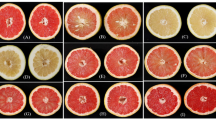Abstract
Grape seeds contain high levels of phytochemicals, that have been associated with a reduced risk of chronic diseases. In this study, the polyphenolic content, antioxidant capacity and antioxidant enzymes activity in the seeds of 20 wild grape accessions native to Iran were investigated. The antioxidant capacity of the wild grape seeds was evaluated by DPPH radical scavenging activity, ferric reducing antioxidant power (FRAP) and Fe2+ chelating. Total phenolic (TP), total flavanoid (TF) and total proanthocyanidin (TPA) content ranged from 44.86 to 155.1, 23.21 to 131.91, and 10.11 to 26.10 mg/g seed, respectively. All seed extracts showed remarkable DPPH radical scavenging activity, ferric reducing antioxidant power (FRAP) and Fe2+ chelating ranging from 27.34 to 78.57%, 198.83 to 590.86 µmol TE/g and 23.12 to 62.98%, respectively. Grape seed extracts had the greatest antioxidant enzymes activity guaiacol peroxidase (G-POD), superoxide dismutase (SOD), and catalase (CAT). Based on HPLC analyses, catechin was the most abundant compound identified (25.89 mg/g) for all accessions. Additionally, significant correlations among different antioxidant assays were found. With the high amount of total phenolic content, antioxidant capacity and antioxidant enzymes activity, seeds of P6, P7 and P8 accessions might be evaluated as a nutritional supplement.

Similar content being viewed by others
References
Arabbi PR, Genovese MI, Lajolo FM (2004) Flavonoids in vegetable foods commonly consumed in Brazil and estimated ingestion by the Brazilian population. J Agric Food Chem 52:1124–1131
Bail S, Stuebiger G, Krist S, Unteweger H, Buchbauer G (2008) Characterization of various grape seed oils by volatile compounds, triacylglycerol composition, total phenols and antioxidant capacity. Food Chem 108:1122–1132
Balasundram N, Sundram K, Samman S (2006) Phenolic compounds in plants and agri-industrial by-products: Antioxidant activity, occurrence, and potential uses. Food Chem 99(1):191–203
Benzie IF, Strain JJ (1996) The ferric reducing ability of plasma (FRAP) as measurement of antioxidant power – the FRAP assay. Anal Biochem 239:70–76
Bozan B, Tosun G, Ozcan D (2008) Study of polyphenol content in the seeds of red grape (Vitis vinifera L.) varieties cultivated in Turkey and their antiradical activity. Food Chem 109:426–430
Carbone F, Preuss A, De Vos RCH, D’Amico E, Perrotta G, Bovy AG, Martens S, Rosati C (2009) Developmental, genetic and environmental factors affect the expression of flavonoid genes, enzymes and metabolites in strawberry fruits. Plant Cell Environ 32:1117–1131
Chance B, Maehly AC (1955) Assay of catalases and peroxidase. Methods Enzymol 2:764–775
Cheynier V, Labarbe B, Moutounet M (2001) Estimation of proanthocyanidin chain length. Methods Enzymol 335:82–97
Dinis TCP, Madeira VMC, Almeida LM (1994) Action of phenolic derivatives (acetaminophen, salicylate, and 5‑amino salicylate) as inhibitors of membrane lipid peroxidation and as peroxyl radical scavengers. Arch Biochem Biophys 315:161–169
Erkan M, Wang SY, Wang CY (2008) Effect of UV treatment on antioxidant capacity, antioxidant enzyme activity and decay in strawberry fruit. Postharvest Biol Tec 48:163–171
Felice F, Zambito Y, Colo GD, D’Onofrio C, Fausto C, Balbarini D, Stefano ARD (2012) Red grape skin and seeds polyphenols: evidence of their protective effects on endothelial progenitor cells and improvement of their intestinal absorption. Eur J Pharm Biopharm 80:176–184
Guo C, Yang J, Wei J, Li Y, Xu J, Jiang Y (2003) Antioxidant activities of peel, pulp, and seed fractions of common fruits as determined by FRAP assay. Nutr Res 23:1719–1726
Hassanpour H, Alizadeh S (2016) Evaluation of phenolic compound, antioxidant activities and antioxidant enzymes of barberry genotypes in Iran. Sci Hortic 200:125–130
Hassanpour H, Hamidoghli Y, Hajilo J, Adlipour M (2011) Antioxidant capacity and phytochemical properties of cornelian cherry (Cornus mas L.) genotypes in Iran. Sci Hortic 129:459–463
Hulya Orak H (2007) Total antioxidant activities, phenolics, anthocyanins and polyphenoloxidase activities of selected red grape cultivars and their correlations. Sci Hortic 111:235–241
Hulya Orak H, Yagar H, Isbilir SS (2012) Comparison of antioxidant activities of juice, peel, and seed of pomegranate (Punica granatum L.) and inter-relationships with total phenolic, tannin, anthocyanin, and flavonoid contents. Food Sci Biotechnol 21(2):373–387
Kanner J, Frankel E, Granit R, German B, Kinsella E (1994) Natural and antioxidants in grapes and wines. J Agric Food Chem 42:64–69
Korekar G, Stobdan T, Arora R, Yadav A, Singh SB (2011) Antioxidant capacity and phenolics content of apricot (Prunus armeniaca L.) kernel as a function of genotype. Plant Foods Hum Nutr 66:376–383
Li H, Wang X, Li P, Li Y, Wang H (2008) Comparative study of antioxidant Activity of grape (Vitis vinifera) seed powder assessed by different methods. J Food Drug Anal 16(6):1–7
Li H, Wang X, Li Y, Li P, Wang H (2009) Polyphenolic compounds and antioxidant properties of selected China wines. Food Chem 112(2):454–460
Li HB, Xia EQ, Deng GF, Guo YJ (2010) Biological activities of polyphenols from grapes. Int J Mol Sci 11(2):622–646
Liang Z, Yang Y, Cheng L, Zhong GY (2012) Polyphenolic composition and content in the ripe berries of wild Vitis species. Food Chem 132:730–738
Makris DP, Boskou G, Andrikopoulos NK (2007) Polyphenolic content in vitro antioxidant characteristics of wine industry and other agri-food solid waste extracts. J Food Compos Anal 20:125–132
Nakajima JI, Tanaka I, Seo S, Yamazaki M, Saito K (2004) LC/PDA/ESI-MS profiling and radical scavenging activity of anthocyanins in various berries. J Biomed Biotechnol 5:241–247
Palma M, Pinero Z, Barroso CG (2001) Stability of phenolic compounds during extraction with superheated solvents. J Chromatogr A 921:169–174
Perez-Magarino S, Gonzales-San Jose MJ (2006) Polyphenols and color variability of red wines made from grape harvested at different ripeness grade. Food Chem 96:197–208
Poudel PR, Tamura H, Kataoka I, Mochioka R (2008) Phenolic compounds and antioxidant activities of skin and seeds of five wild grapes and two hybrids native to Japan. J Food Compost Anal 21:622–625
Prieur C, Rigaud J, Cheynier V, Moutounet M (1994) Oligomeric and polymeric proanthocyanidins from grape seeds. Phytochemistry 36(3):781–784
Renaud S, De Lorgeril M (1992) Wine, alcohol, platelets, and the French paradox for coronary heart disease. Lancet 339:1523–1526
Revilla E, Carrasco D, Benito A, Arroyo-Garcia R (2010) Anthocyanin composition of several wild grape accessions. Am J Enol Viticult 61(4):536–543
Robichaud JL, Noble AC (1990) Astringency and bitterness of selected phenolics in wine. J Sci Food Agric 53(3):343–352
Rockenbach I, Rodrigues E, Gonzaga LV, Caliari V, Genovese MI, Gonçalves A, Fett R (2011) Phenolic compounds content and antioxidant activity in pomace from selected red grapes (Vitis vinifera L. and Vitis labrusca L.) widely produced in Brazil. Food Chem 127:174–179
Samah MI, Sahar SAS, Khaled AS, Hoda MHA (2012) Phenolic compounds and antioxidant activity of white, red, black grape skin and white grape seeds. Life Sci J 9(4):3464–3474
Santos Buelgo C, Scalbert A (2000) Proanthocyanidins and tannin like compounds-nature occurrence dietary intake and effects on nutrition and health. J Sci Food Agric 80:1094–1117
Singha I, Kumar Das S (2014) Antioxidant potential of different grape cultivars against fenton-like reagent-induced liver damage ex-vivo. Indian J Biochem Biophys 51:372–377
Slinkard K, Singleton VL (1977) Total phenol analyses: automation and comparison with manual methods. Am J Enol Vitic 28:49–55
Teissedre PL, Frankel EN, Waterhouse AL, Peleg H, German JB (1996) Inhibition of in vitro human LDL oxidation by phenolic antioxidants from grapes and wines. J Sci Food Agric 70:55–61
Thayer WS (1990) Superoxide-dependent and superoxide-independent pathways for reduction of nitroblue tetrazolium in isolated rat cardiac myocytes. Arch Biochem 276:139–145
Xu C, Yang Y, Cao L, Jiang L (2010) Phenolic compounds and antioxidant properties of different grape cultivars grown in China. Food Chem 119:1557–1565
Youngjae S, Ruihai L, Jacqueline F, Nockc DH, Christopher BW (2007) Temperature and relative humidity effects on quality, total ascorbic acid, phenolics and flavonoid concentrations, and antioxidant activity of strawberry. Postharvest Biol Technol 45:349–357
Zhang Z, Nakano K, Maezawa S (2009) Comparison of the antioxidant enzymes of broccoli after heat shock treatment at different storage temperatures. Postharvest Biol Technol 54:101–105
Author information
Authors and Affiliations
Corresponding author
Ethics declarations
Conflict of interest
H. Hassanpour and R. Khoshamad declare that they have no competing interests.
Rights and permissions
About this article
Cite this article
Hassanpour, H., Khoshamad, R. Antioxidant Capacity, Phenolic Compounds and Antioxidant Enzymes of Wild Grape Seeds from Different Accessions Grown in Iran. Erwerbs-Obstbau 59, 281–290 (2017). https://doi.org/10.1007/s10341-017-0323-0
Received:
Accepted:
Published:
Issue Date:
DOI: https://doi.org/10.1007/s10341-017-0323-0




